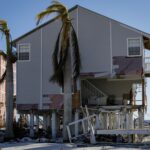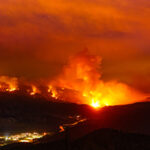Wildfires across the western United States will leave insurers with a “multi-billion-dollar” bill, Aon concluded in its September 2020 Global Catastrophe Recap.
While it will likely take some time to determine final insurance payouts, early signs point to some ominous costs.
Aon pointed out that “significant wildfires” continued burning throughout the U.S. west coast in September, causing catastrophic impacts in California, Oregon, Washington and Colorado. Fires destroyed thousands of homes and structures in Oregon and Washington in particular, and Aon said direct economic costs from blazes in California, Oregon and Washington alone “were likely to reach well into the billions of dollars.”
Making the wildfires worse were elements including “record heat, minimal precipitation, and two notably strong offshore wind events,” Aon said.
Fires have been a particular problem in the U.S. so far in 2020, with 22 fires burning at least 100,000 acres to date. As well, at least 43 people have died in seasonal fire-related events, according to the report.
In California alone, five of the state’s six largest fire events since 1932 were recorded in August and September; along with five of the state’s top 20 most destructive fires on record.
Other catastrophe events of note from September, as cited in the Aon Report:
Severe storms hit parts of Minnesota, Iowa, Wisconsin, and Illinois on September 5-6, bringing reports of hailstones approaching and exceeding 2 inches to regions of Minnesota. A maximum measured straight-line wind gust of 83 mph (133 kph) occurred in Iowa, leading to downed trees and powerlines through multiple regions. Total economic losses were estimated at $165 million, most of which was covered by insurance.
A unusually strong cold front that progressed across the western two-thirds of the country from September 7-9 spawned high winds that reached hurricane force and caused notable damage in parts of Utah and Idaho. One person was killed. At least 170,000 customers lost power in Utah. Total economic losses were estimated at $375 million.
A narrow corridor of extremely heavy precipitation across portions of Maryland, Virginia, and the District of Columbia (D.C.) produced rainfall amounts approaching and exceeding 3 to 6 inches on September 10. Personnel performed numerous water rescues as rising flooding waters affected transportation and trapped motorists. Total economic and insured losses were estimated in the low millions (USD).
After bringing heavy rains and flooding to South Florida and the Florida Keys on September 11-12, Hurricane Sally came ashore near Gulf Shores, Alabama on September 16 as a 105 mph (165 kph) Category 2 storm. At least eight fatalities and several injuries were reported. In addition to hurricane force wind gusts and notable storm surge, the storm caused between 20 to 30 inches of rain across sections of coastal Alabama and the Florida Panhandle. Afterwards, the slow-moving cyclone brought torrential rainfall and severe weather well-inland with flooding observed in parts of Georgia and the Carolinas. Total economic losses were estimated beyond $5 billion. Public and private insurance losses exceeded $2.5 billion.
Tropical Storm Beta meandered in the Gulf of Mexico before making landfall along the southern end of the Matagorda Peninsula near Port O’Connor (Texas) on September 21 with maximum sustained winds of 45 mph. The storm’s slow movement brought heavy rainfall and flash flooding to coastal Texas and Louisiana before its remnants progressed over the Southeast and Mid-Atlantic states between September 21-25. One of the Top 5 wettest three-day rainfall totals on record in Houston was recorded, along with major flooding elsewhere in Harris County (Texas). Total economic losses were estimated to exceed $100 million.
Source: Aon




















 That Insurance Talent Crisis? It’s a Global Knowledge Opportunity
That Insurance Talent Crisis? It’s a Global Knowledge Opportunity  If U.S. Inflation Reflected Rising Home Insurance Costs, It’d Be Even Higher
If U.S. Inflation Reflected Rising Home Insurance Costs, It’d Be Even Higher  Underwriters’ Dilemma: Is AI a Cyber or Tech E&O Risk?
Underwriters’ Dilemma: Is AI a Cyber or Tech E&O Risk?  Time-Tested Loss Reserving Methods Challenged: AM Best
Time-Tested Loss Reserving Methods Challenged: AM Best 






